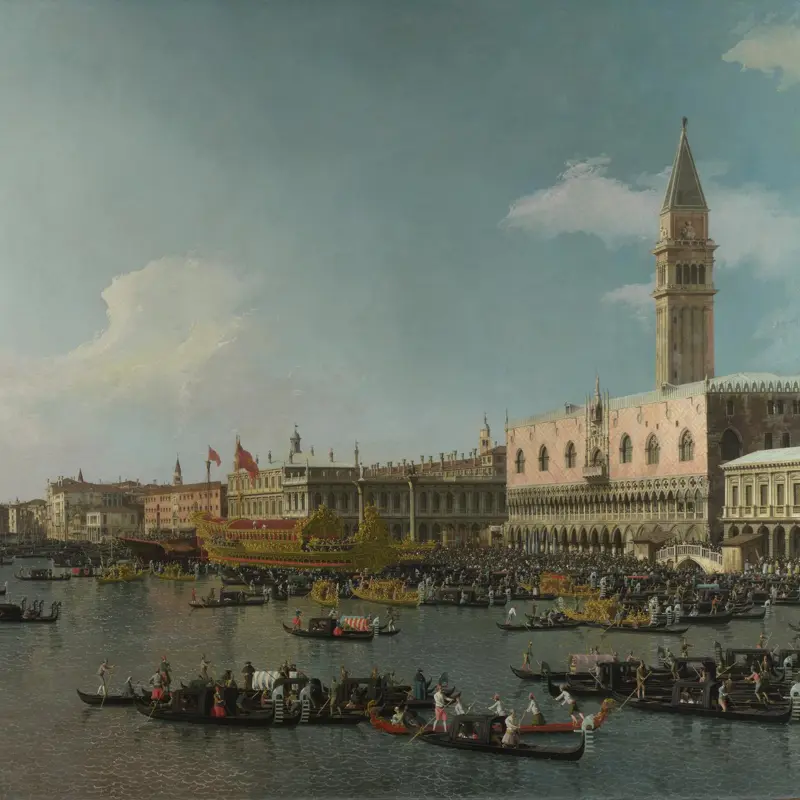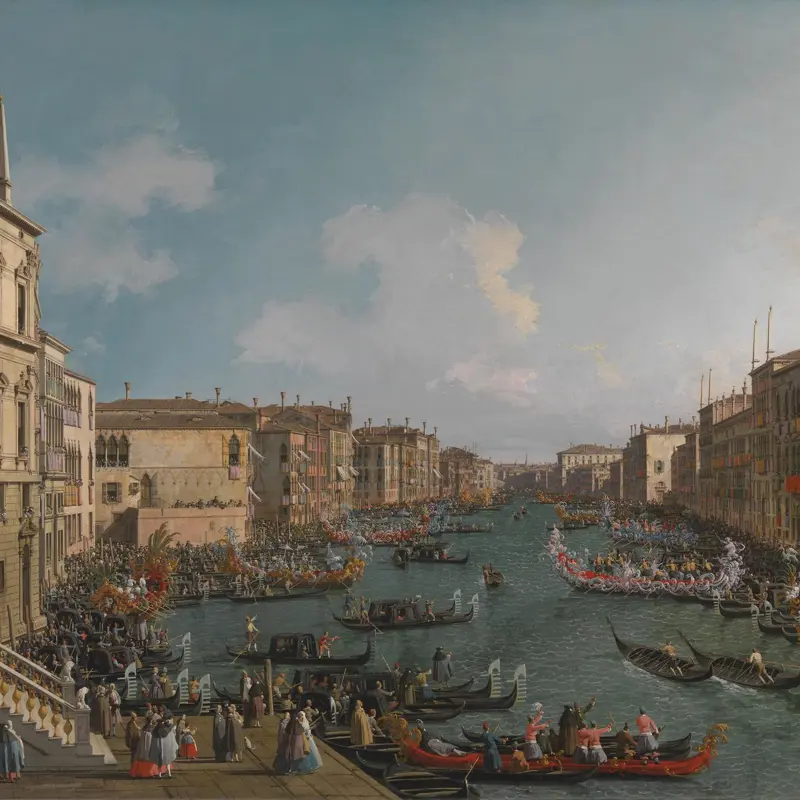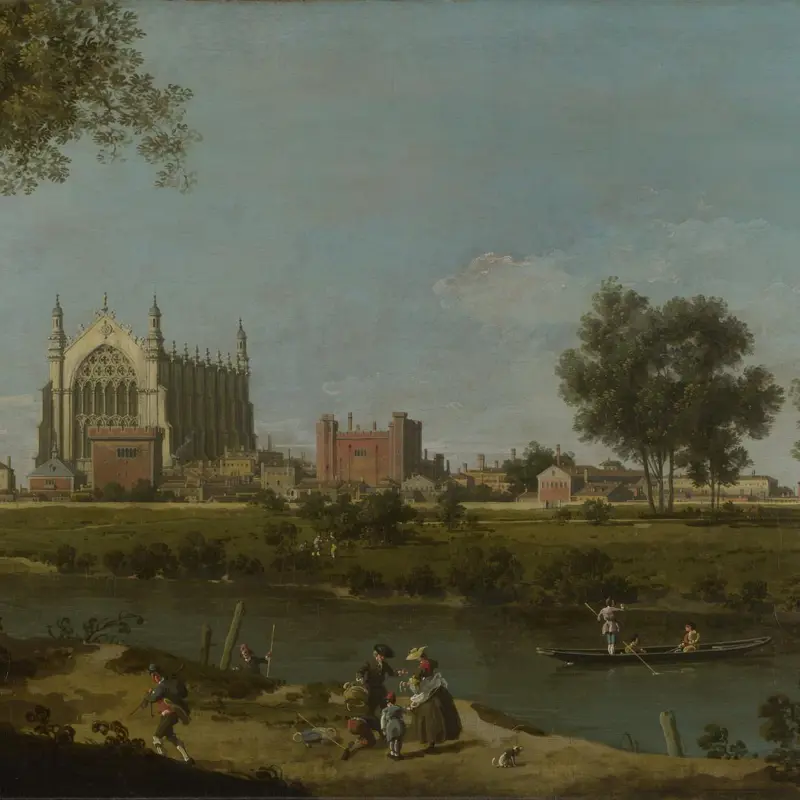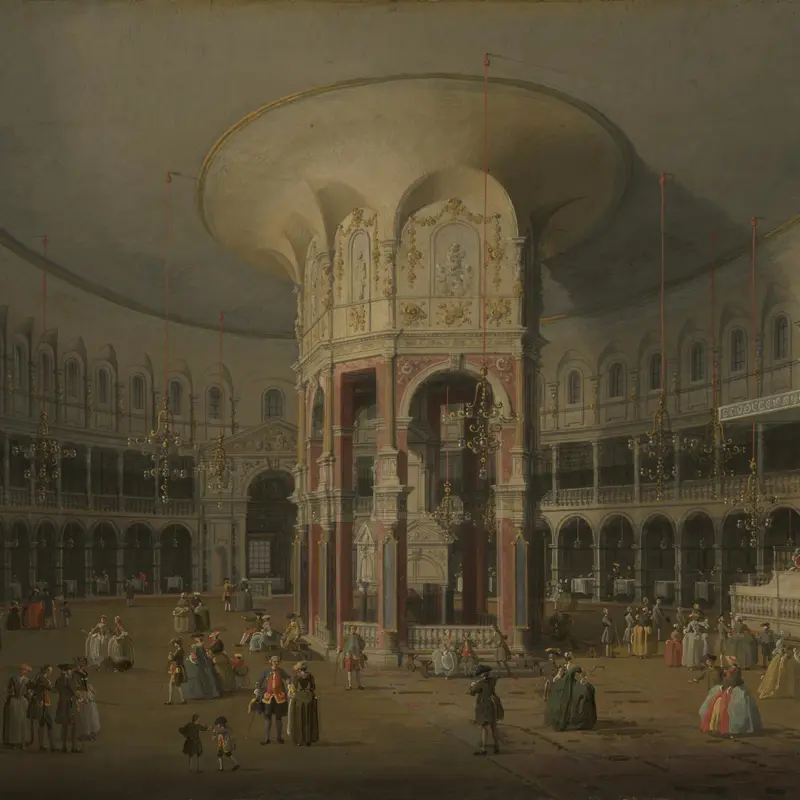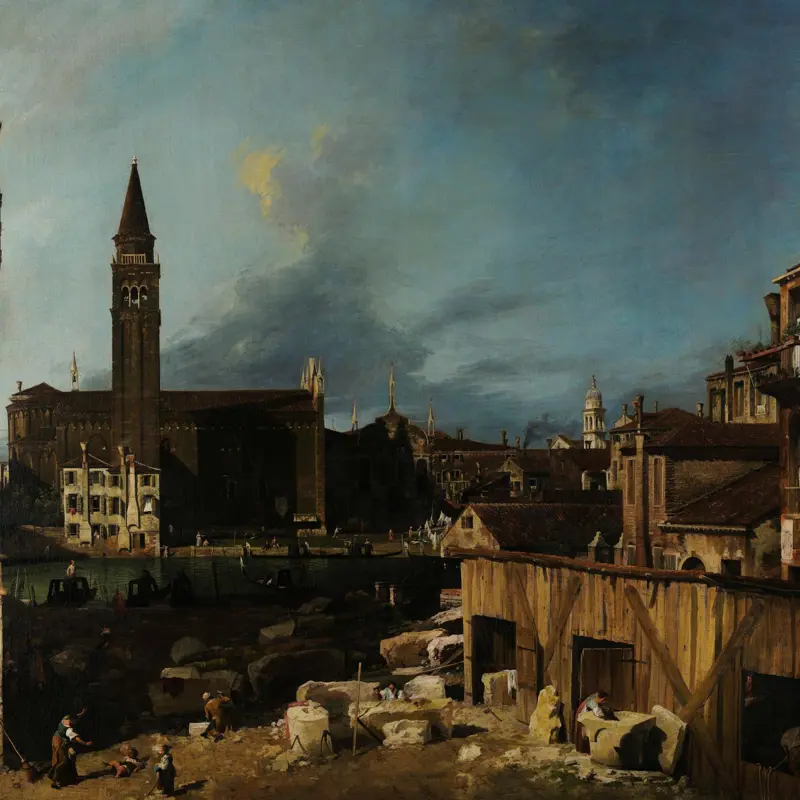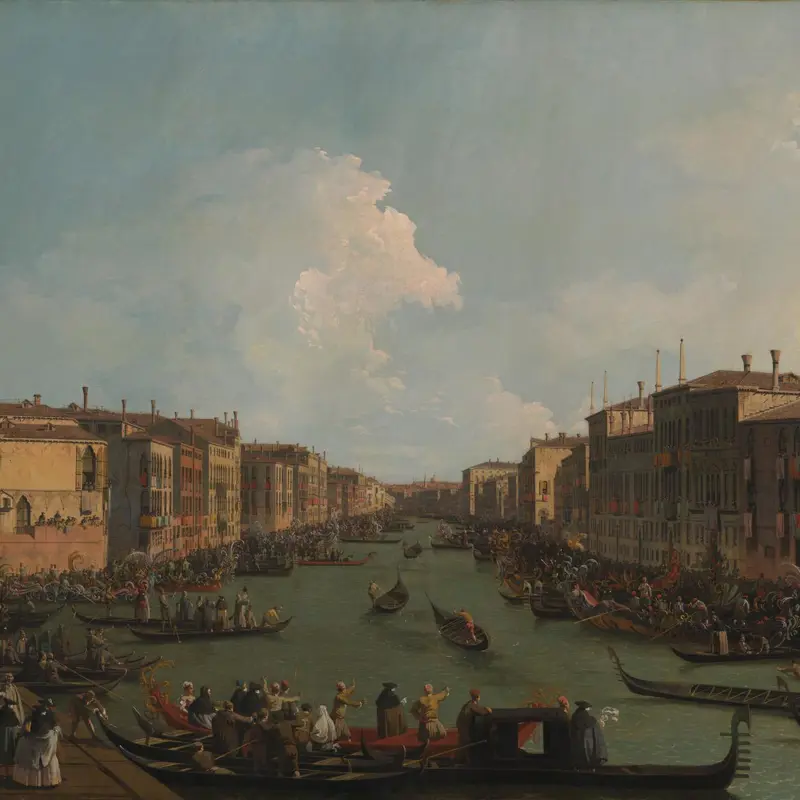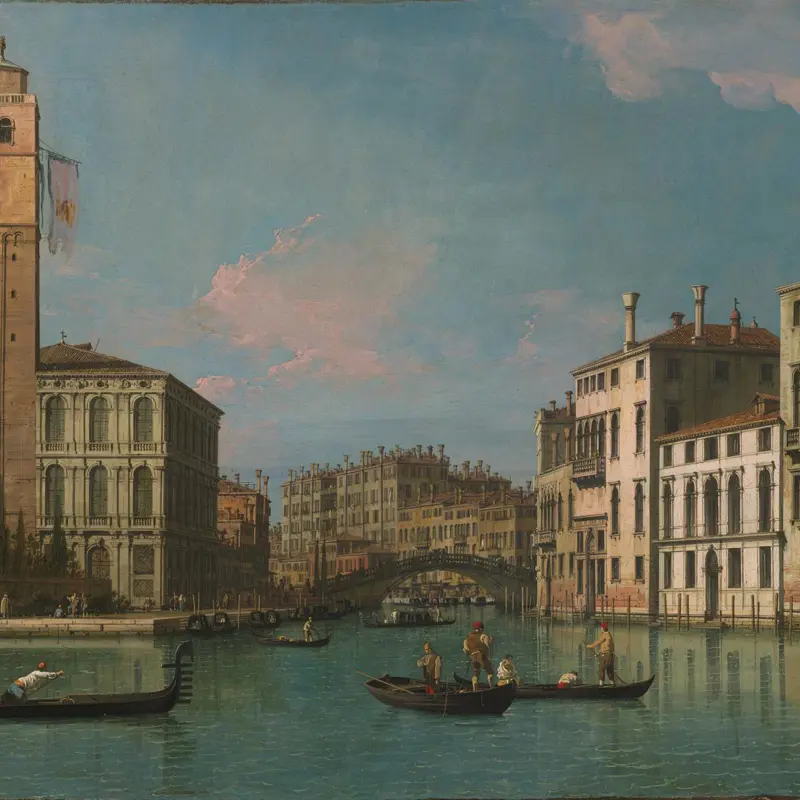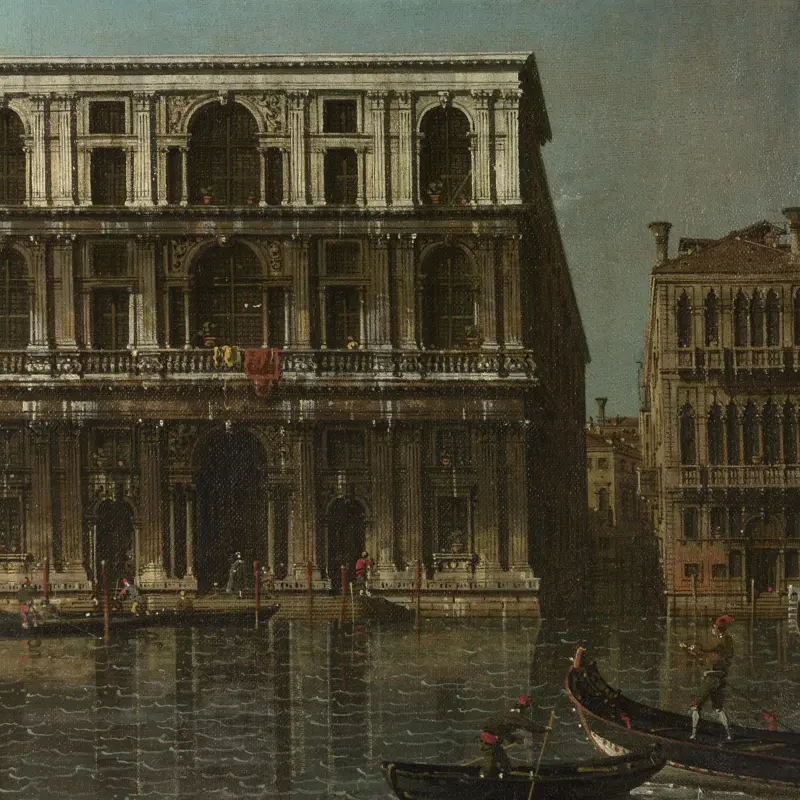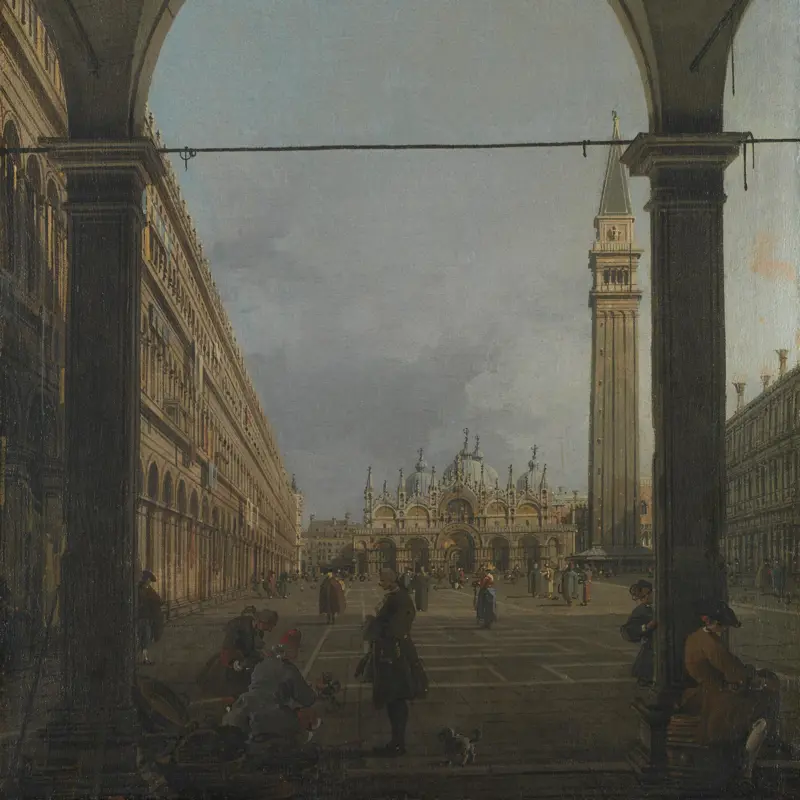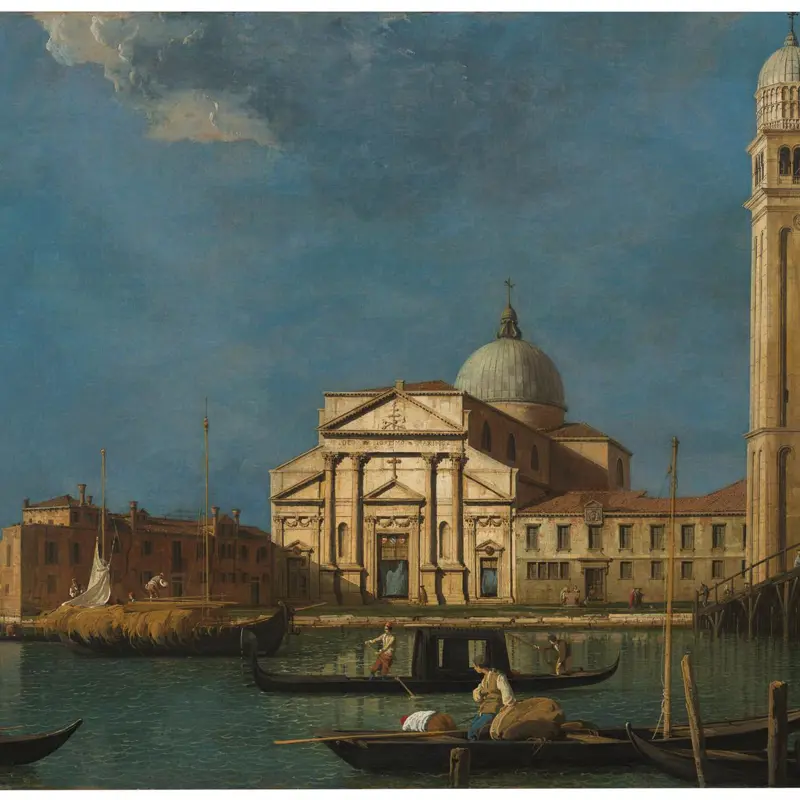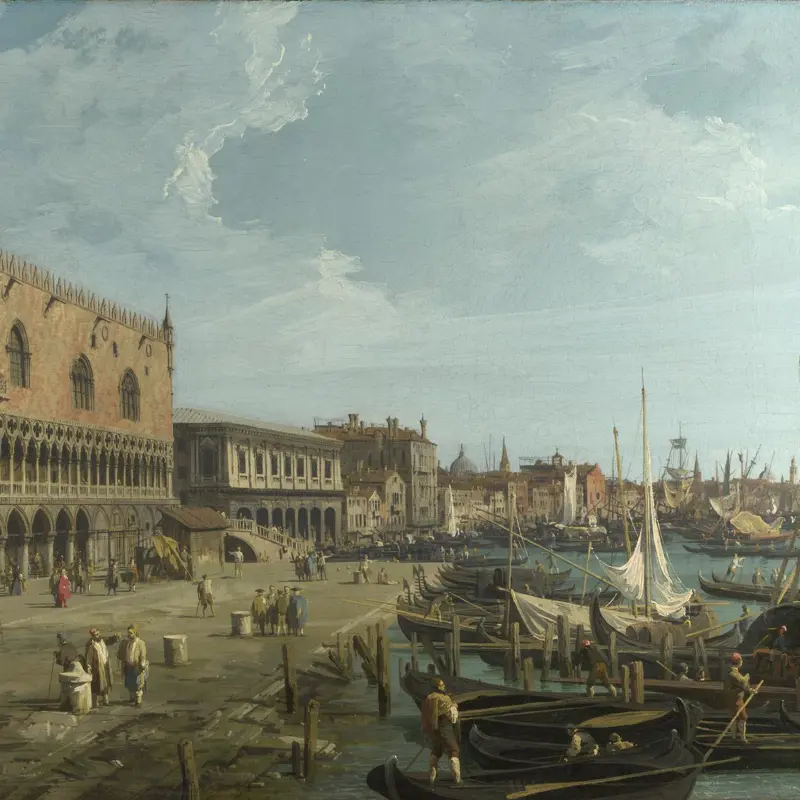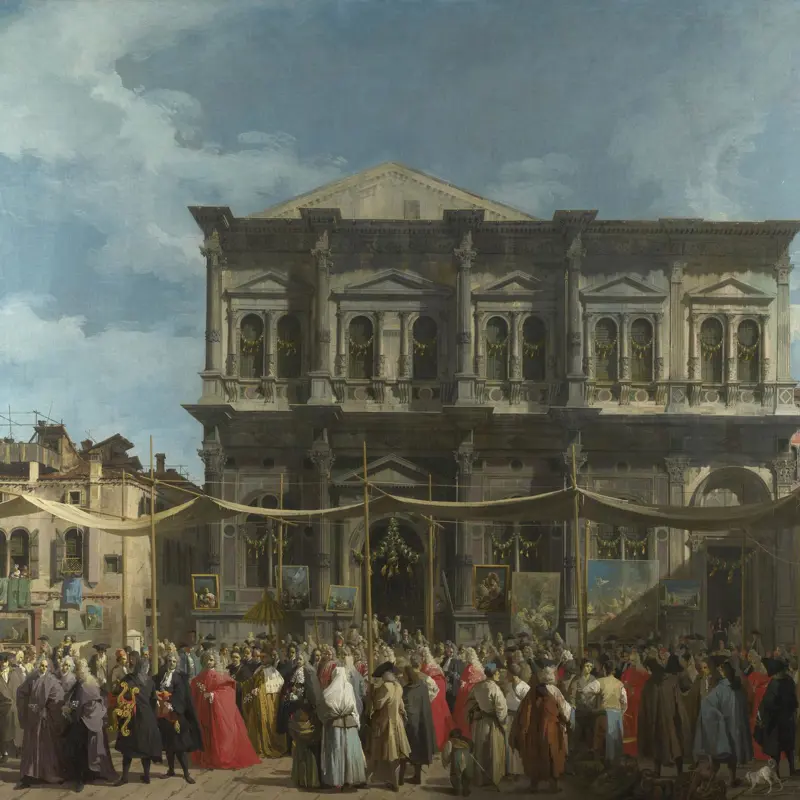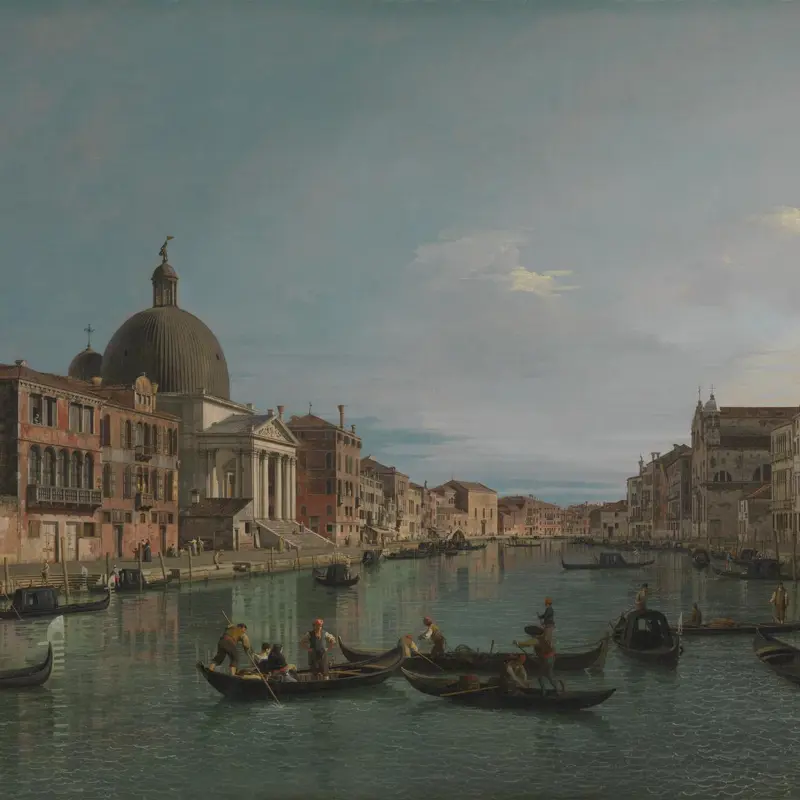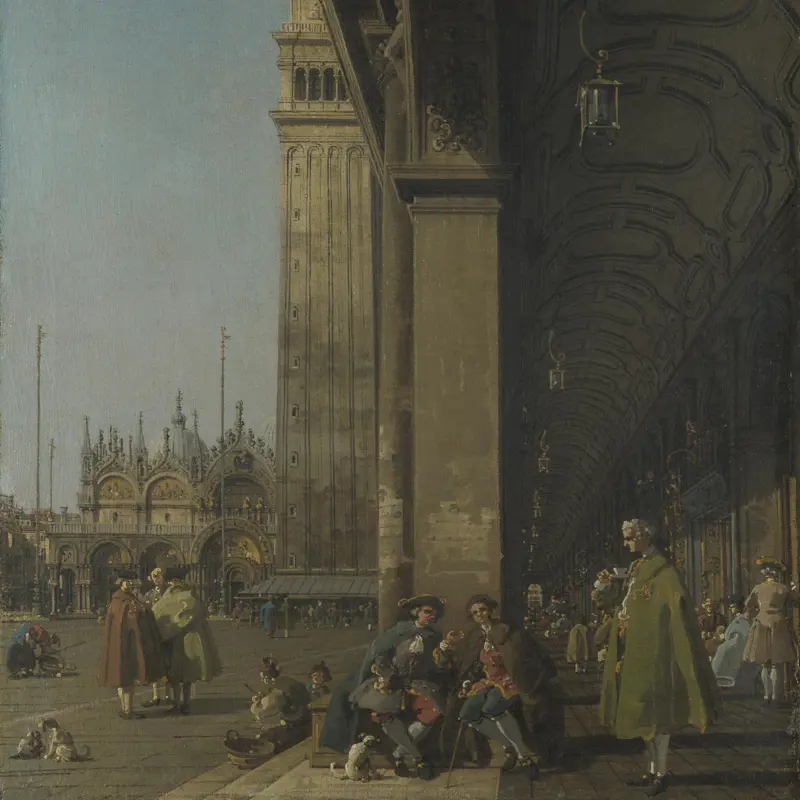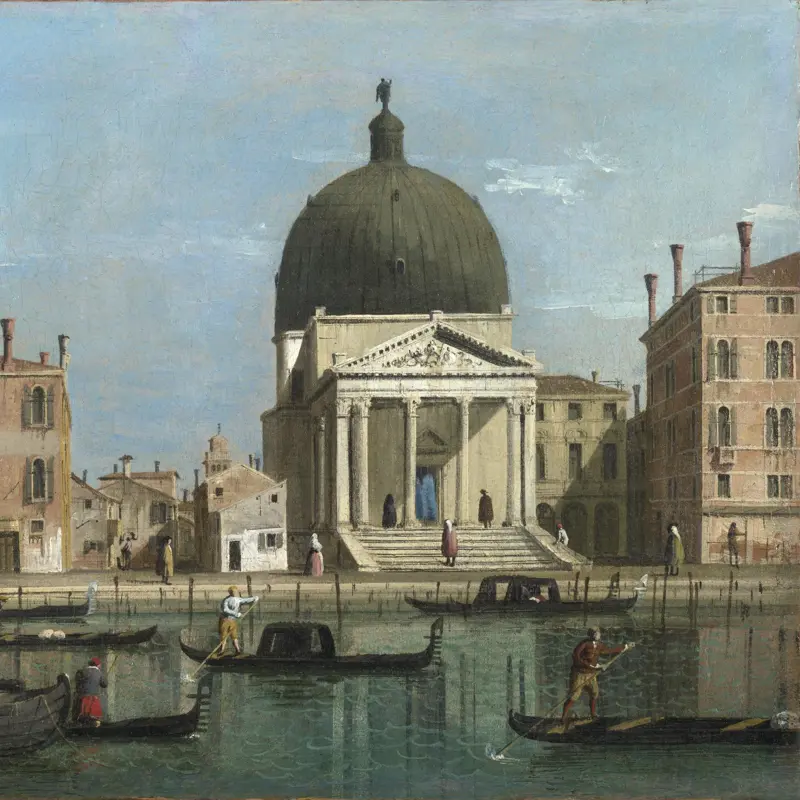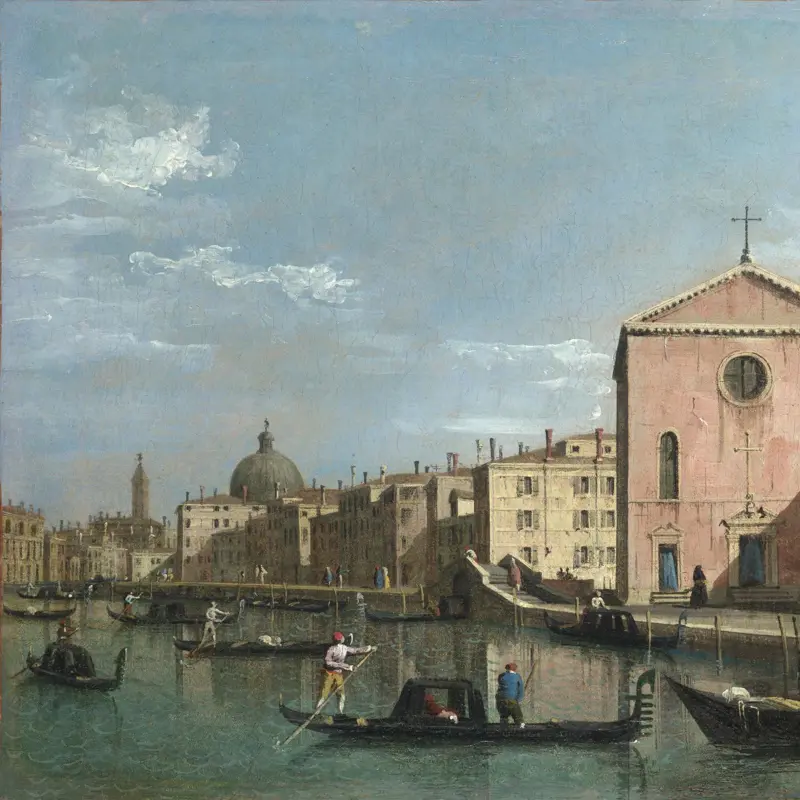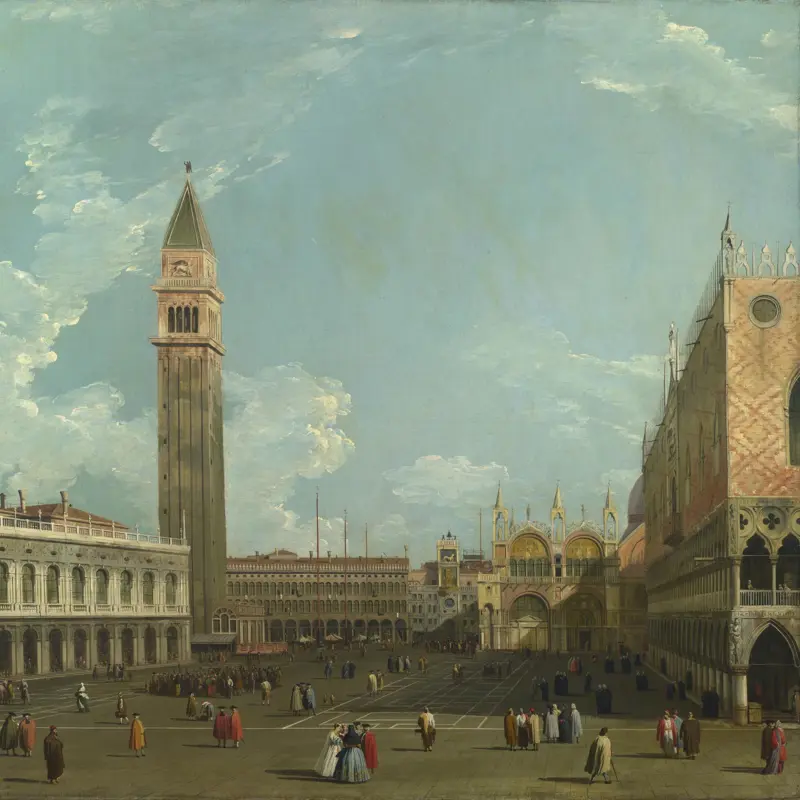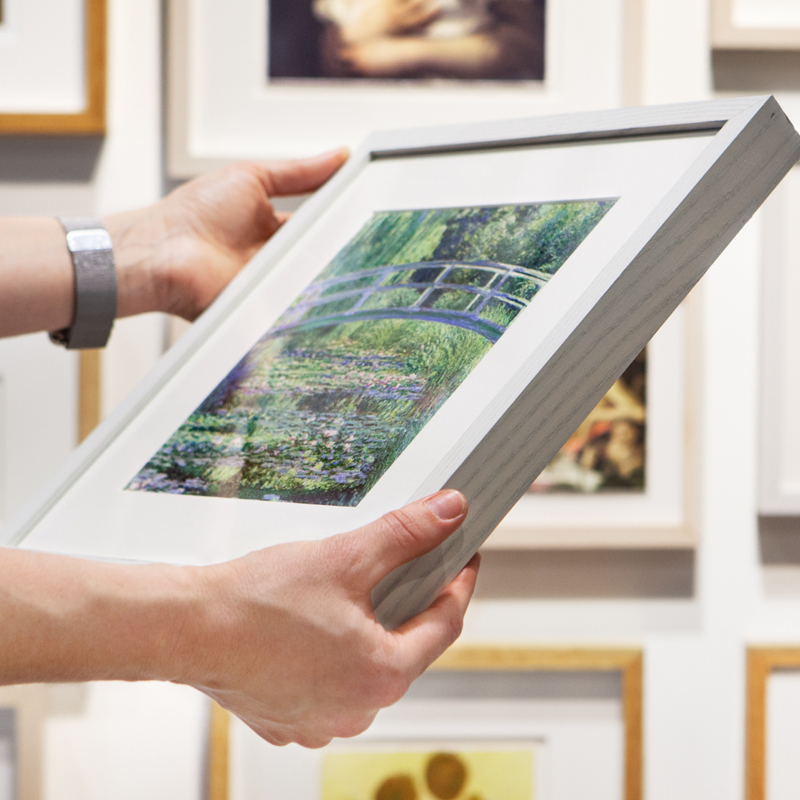Canaletto, 'A Regatta on the Grand Canal', about 1740
About the work
Overview
We have a magnificent view of the Grand Canal in Venice during the annual regatta, which was held on 2 February and attracted large numbers of visitors each year. All eyes are on the one-oared gondolas racing up the middle of the canal. Just right of centre two craft swing around the bend, tilted and almost touching, trying to catch up with the leaders. Another boat follows on the far right. Spectators cheer from windows and balconies, from gondolas and lavishly decorated bissone (eight- or ten-oared boats).
Canaletto has captured the drama of the event, with spectators and architecture laid out at a steep angle that recedes sharply into the distance and focuses our eye on the race. The animated crowd and the boats jostling for position help to create a feeling of excitement, while the ripples on the canal’s surface, which may look sketchy close up, give the water depth and movement from a distance.
Audio description
Listen to an audio description of Canaletto's 'A Regatta on the Grand Canal'
Transcript
This is a description of 'A Regatta on the Grand Canal', painted in oil on canvas in about 1740, by the Venetian artist Giovanni Antonio Canal, known as Canaletto, or ‘little Canal’. It is over a metre tall and almost two metres wide.
The painting shows an exciting outdoor scene on Venice’s main water thoroughfare, under a wide expanse of calm blue sky, which fills the top half of the painting. A gondola race, part of a regatta, is taking place. On either side of the wide Grand Canal the beautiful waterfront palaces, decorated with cloths in a rainbow of colour, recede sharply into the distance, in a steep perspective. In the distant background, where the waterway turns to the left, is the famous Rialto bridge.
Bright sunlight glints on the water, the gilded boats and the spectacular outfits of the crowd, who throng in their thousands. They throng from the balconies and the banks, or cheer from gondolas and lavishly decorated boats which line the route. The scene is a riot of colour, movement and noise, every inch crammed with intricate details .
The finely painted architecture of the palaces, fronting the canal, would be recognisable to visitors to Venice today, such as the Palazzo Balbi on the left of the painting, with tall obelisks on its roof. Other buildings are topped with spire-like chimneys, no longer there today..
Also on the left, in the foreground, is a white building with steps and columns, gleaming in pink and gold. This is the macchina della regatta - a temporary structure made from wood, plaster and papier mâché. This elaborate carnival float was built especially for the race, acting as the finishing line, where the prizes would be given out. Rowers would race past it, to the far end of the Grand Canal, turn around and then speed back up, to finish outside it. Two thin black gondolas are slicing up the middle of the canal, tilted over and jostling for position. Travelling away from us, each has a single gondolier, standing upright with one oar. A third gondola races into the picture from the right. The gondolas would have been rowed by people who used boats in their day-to-day jobs, each representing a different Venetian family. The most skilled rowers could become working-class heroes celebrated throughout the city.
The lavishly decorated boats lining the banks are bissone, eight-oared parade boats which would have started the regatta by leading a colourful procession. Some are adorned with golden mythological figures and animals, others have an oriental theme to their silvery decorations. The boats carry Venetian nobles, who recline on velvet cushions, and rowers in colourful uniforms.
Many of the distant figures are created with just a few skilful dots and flicks of paint, but in the foreground more detail has been added to the clusters of figures wearing purple and blue dresses under black cloaks. Several wear traditional white Bauta masks, black three-cornered hats and cloaks. These were not only worn at regattas but for various special events such as theatre and festivals.
These lavish spectacles attracted large numbers of visitors to the City each year, including wealthy, upper-class Europeans on the Grand Tour, which were trips for education and pleasure. Canaletto capitalised on their excitement and his views of Venice, known as ‘vedute’ were in high demand.
This work and its companion piece, The Basin of San Marco on Ascension Day, are among the grandest views of Venice that Canaletto made. He and his studio painted many versions, both with and without regattas taking place. No one bought more of these than the British. There are more paintings of Venice by Canaletto in one room of the National Gallery than there are in all of the public galleries in Venice!
Key facts
Details
- Full title
- A Regatta on the Grand Canal
- Artist
- Canaletto
- Artist dates
- 1697 - 1768
- Part of the series
- Two Venetian Ceremonial Scenes
- Date made
- About 1740
- Medium and support
- Oil on canvas
- Dimensions
- 122.1 × 182.8 cm
- Acquisition credit
- Bequeathed by Lord Revelstoke, 1929
- Inventory number
- NG4454
- Location
- Room 33
- Collection
- Main Collection
- Frame
- 18th-century English Frame (original frame)
Provenance
Additional information
Text extracted from the ‘Provenance’ section of the catalogue entry in Michael Levey, ‘National Gallery Catalogues: The Seventeenth and Eighteenth Century Italian Schools’, London 1986; for further information, see the full catalogue entry.
Exhibition history
-
2015The National Gallery Masterpiece Tour: Canaletto's 'A Regatta on the Grand Canal'Victoria Art Gallery (Bath)7 March 2015 - 3 May 2015Compton Verney9 May 2015 - 21 June 2015Sunderland Museum and Winter Gardens11 July 2015 - 13 September 2015
Bibliography
-
1956Levey, Michael, National Gallery Catalogues: The Eighteenth Century Italian Schools, London 1956
-
1986Levey, Michael, National Gallery Catalogues: The Seventeenth and Eighteenth Century Italian Schools, London 1986
-
2001
C. Baker and T. Henry, The National Gallery: Complete Illustrated Catalogue, London 2001
About this record
If you know more about this work or have spotted an error, please contact us. Please note that exhibition histories are listed from 2009 onwards. Bibliographies may not be complete; more comprehensive information is available in the National Gallery Library.
Images
About the series: Two Venetian Ceremonial Scenes

Overview
This pair of paintings – A Regatta on the Grand Canal and The Basin of San Marco on Ascension Day – captures two of the most popular annual festivals in eighteenth-century Venice: the gondola races and the Wedding of the Sea ceremony. Both fell into decline during the late eighteenth century but were revived in 1965 and are still enjoyed today.
Both events celebrate the history of the Venetian Republic. The regatta commemorates a naval victory against the forces of Dalmatia (modern-day Croatia) around the year 1000; the Wedding of the Sea relates to a peace treaty of 1178 between the Holy Roman Empire and the papacy, witnessed by the Doge (elected head) of Venice. He received a blessed ring from the Pope.
The paintings were made around 1740, when Canaletto produced his most commercially successful works. They were designed to appeal to wealthy foreign visitors as a reminder of Venice’s outstanding beauty and unique entertainments.

